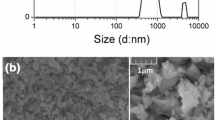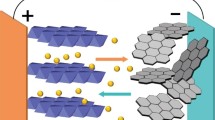Abstract
Recently, rare-earth perovskite-type oxides with the general formula ABO3 (A rare earth element, B transition metal, O oxygen) are regarded as promising materials for Ni/oxide batteries due to their hydrogen storage ability. In the present study, the hydrogen storage properties of the rare-earth perovskite-type oxide La0.6Sr0.4Co0.2Fe0.8O3 were evaluated in alkaline solution and at various temperatures. The hydrogen storage properties were investigated electrochemically by applying galvanostatic charge/discharge currents. Electrochemical pressure–composition–temperature isotherms were constructed using the Nernst equation. The exchange current density and proton hydrogen diffusion coefficient were calculated using linear polarization measurements and the potential-step method, respectively. Interestingly, the maximum hydrogen absorption capacity, re-calculated from the electrochemical capacity, is 1.72 wt% at 333 K and 6 mol·L−1 KOH. In addition, the hysteresis value, calculated from pressure–composition–temperature isotherms, was 429 J·mol−1 at 333 K, while the self-discharge rate was about 25% after 24-h storage at open circuit and at 333 K.








Similar content being viewed by others
References
Larcher D, Tarascon JM. Towards greener and more sustainable batteries for electrical energy storage. Nat Chem. 2015;7(1):19.
Chien TK, Chiou LY, Lee CC, Chuang YC, Ke SH, Sheu SS, Wu CI. An energy-efficient nonvolatile microprocessor considering software-hardware interaction for energy harvesting applications. In: VLSI Design, Automation and Test (VLSI-DAT) 2016 International Symposium on. Hsinchu, Taiwan; 2016. 1.
Ouyang L, Huang J, Wang H, Liu J, Zhu M. Progress of hydrogen storage alloys for Ni–MH rechargeable power batteries in electric vehicles: a review. Mater Chem Phys. 2017;200:164.
Cao Z, Ouyang L, Li L, Lu Y, Wang H, Liu J, Tang R. Enhanced discharge capacity and cycling properties in high-samarium, praseodymium/neodymium-free, and low-cobalt A2B7 electrode materials for nickel-metal hydride battery. Int J Hydrogen Energy. 2015;40(1):451.
Ouyang LZ, Cao ZJ, Li LL, Wang H, Liu JW, Min D, Zhu M. Enhanced high-rate discharge properties of La11.3Mg6.0Sm7.4Ni61.0Co7.2Al7.1 with added graphene synthesized by plasma milling. Int J Hydrogen Energy. 2014;39(24):12765.
Divya KC, Østergaard J. Battery energy storage technology for power systems: an overview. Electr Power Syst Res. 2009;79(4):511.
Malhotra A, Battke B, Beuse M, Stephan A, Schmidt T. Use cases for stationary battery technologies: a review of the literature and existing projects. Renew Sustain Energy Rev. 2016;56:705.
Young KH, Ng KY, Bendersky LA. A technical report of the robust affordable next generation energy storage system-BASF program. Batteries. 2016;2(1):2.
Bertuol DA, Bernardes AM, Tenório JAS. Spent NiMH batteries: characterization and metal recovery through mechanical processing. J Power Sources. 2006;160(2):1465.
Al-Thyabat S, Nakamura T, Shibata E, Iizuka A. Adaptation of minerals processing operations for lithium-ion (LiBs) and nickel metal hydride (NiMH) batteries recycling: critical review. Miner Eng. 2013;45:4.
Young KH. Research in nickel/metal hydride batteries. Batteries. 2016;2(4):31.
Yartys V, Noréus D, Latroche M. Metal hydrides as negative electrode materials for Ni–MH batteries. Appl Phys A. 2016;122(1):43.
Chang S, Young KH, Nei J, Fierro C. Reviews on the US Patents regarding nickel/metal hydride batteries. Batteries. 2016;2(2):10.
Wang L, Young K, Nei J, Pawlik D, Ng KYS. Hydrogenation of AB5 and AB2 metal hydride alloys studied by in situ X-ray diffraction. J Alloy Compd. 2014;616:300.
Henao J, Martinez-Gomez L. On rare-earth perovskite-type negative electrodes in nickel–hydride (Ni/H) secondary batteries. Mater Renew Sustain Energy. 2017;6(2):7.
Aoki Y, Kobayashi S, Yamaguchi T, Tsuji E, Habazaki H, Yashiro K, Ohtsuka T. Electrochemical impedance spectroscopy of high-efficiency hydrogen membrane fuel cells based on sputter-deposited BaCe0.8Y0.2O3−δ thin films. J Phys Chem C. 2016;120(29):15976.
Zhang H, Yi J, Jiang X. Fast response, highly sensitive and selective mixed-potential H2 sensor based on (La, Sr)(Cr, Fe)O3-δ perovskite sensing electrode. ACS Appl Mater Interfaces. 2017;9(20):17218.
Zhu T, Fowler DE, Poeppelmeier KR, Han M, Barnett SA. Hydrogen oxidation mechanisms on perovskite solid oxide fuel cell anodes. J Electrochem Soc. 2016;163(8):F952.
Esaka T, Sakaguchi H, Kobayashi S. Hydrogen storage in proton-conductive perovskite-type oxides and their application to nickel–hydrogen batteries. Solid State Ionics. 2004;166(3):351.
Sakaguchi H, Hatakeyama K, Kobayashi SS, Esaka T. Hydrogenation characteristics of the proton conducting oxide–hydrogen storage alloy composite. Mater Res Bull. 2002;37(9):1547.
Wang Q, Deng G, Chen Z, Chen Y, Cheng N. Electrochemical hydrogen property improved in nano-structured perovskite oxide LaFeO3 for Ni/MH battery. J Appl Phys. 2013;113(5):053305-1.
Deng G, Chen Y, Tao M, Wu C, Shen X, Yang H. Electrochemical properties of La1−xSrxFeO3 (x = 0.2, 0.4) as negative electrode of Ni–MH batteries. Electrochim Acta. 2009;54(15):3910.
Lubini M, Chinarro E, Moreno B, de Sousa VC, Alves AK, Bergmann CP. Electrical properties of La0.6Sr0.4Co1–yFeyO3 (y = 0.2–1.0) fibers obtained by electrospinning. J Phys Chem C. 2015;120(1):64.
Feng F, Northwood DO. Self-discharge characteristics of a metal hydride electrode for Ni–MH rechargeable batteries. Int J Hydrogen Energy. 2005;30(12):1367.
Shang GY, Han SM, Hao JS, Liu Y, Zhu XL, Li Y, Xie DY. Study on self-discharge property of Nd0.88Mg0.12Ni3.10+x Al0.20 (x = 0.00, 0.10, 0.20, 0.30) hydrogen storage alloys. J Alloy Compd. 2010;493(1):573.
Goo NH, Lee KS. The electrochemical hydriding properties of Mg–Ni–Zr amorphous alloy. Int J Hydrogen Energy. 2002;27(4):433.
Wang CS, Wang XH, Lei YQ, Chen CP, Wang QD. A new method of determining the thermodynamic parameters of metal hydride electrode materials. Int J Hydrogen Energy. 1997;22(12):1117.
Song M, Chen Y, Tao M, Wu C, Zhu D, Yang H. Some factors affecting the electrochemical performances of LaCrO3 as negative electrodes for Ni/MH batteries. Electrochim Acta. 2010;55(9):3103.
Wjihi S, Sellaoui L, Bouzid M, Dhaou H, Knani S, Jemni A, Lamine AB. Theoretical study of hydrogen sorption on LaNi5 using statistical physics treatment: microscopic and macroscopic investigation. Int J Hydrogen Energy. 2017;42(5):2699.
Wang Q, Chen Z, Chen Y, Cheng N, Hui Q. Hydrogen storage in perovskite-type oxides ABO3 for Ni/MH battery applications: a density functional investigation. Ind Eng Chem Res. 2011;51(37):11821.
Raju M, Ananth MV, Vijayaraghavan L. Influence of temperature on the electrochemical characteristics of MmNi3.03Si0.85Co0.60Mn0.31Al0.08 hydrogen storage alloys. J Power Sources. 2008;180(2):830.
Charbonnier V, Monnier J, Zhang J, Paul-Boncour V, Joiret S, Puga B, Latroche M. Relationship between H2 sorption properties and aqueous corrosion mechanisms in A2Ni7 hydride forming alloys (A = Y, Gd or Sm). J Power Sources. 2016;326:146.
Liu Y, Pan H, Gao M, Zhu Y, Lei Y, Wang Q. The electrochemical performance of a La–Mg–Ni–Co–Mn metal hydride electrode alloy in the temperature range of − 20 to 30 °C. Electrochim Acta. 2004;49(4):545.
Garche J, Dyer CK, Moseley PT, Ogumi Z, Rand DA, Scrosati B. Encyclopedia of electrochemical power sources. Netherlands: Elsevier; 2003. 397.
Henao J, Sotelo O, Casales M, Martinez-Gomez L. Electrochemical performance of the rare-earth perovskite-type oxide La0.6Sr0.4Co0.2Fe0.8O3 as negative electrode material for Ni/oxide rechargeable batteries. Mater Renew Sustain Energy. 2017;6(4):16.
Mosavati N, Young KH, Meng T, Simon Ng KY. Electrochemical open-circuit voltage and pressure-concentration-temperature isotherm comparison for metal hydride alloys. Batteries. 2016;2(2):6.
Volodin AA, Wan C, Denys RV, Tsirlina GA, Tarasov BP, Fichtner M, Yartys VA. Phase-structural transformations in a metal hydride battery anode La1.5Nd0.5MgNi9 alloy and its electrochemical performance. Int J Hydrogen Energy. 2016;41(23):9954.
Feinberg M. On Gibbs’ phase rule. Arch Ration Mech Anal. 1979;70(3):219.
Young K, Young M, Chang S, Huang B. Synergetic effects in electrochemical properties of ZrVxNi4.5−x (x = 0.0, 0.1, 0.2, 0.3, 0.4, and 0.5) metal hydride alloys. J Alloy Compd. 2013;560:33.
Young K, Ouchi T, Mays W, Reichman B, Fetcenko MA. Pressure–composition–temperature hysteresis in C14 Laves phase alloys: part 2. Applications in NiMH batteries. J Alloy Compd. 2009;480(2):434.
Wong DF, Young K, Ng KYS. First-principles study of structure, initial lattice expansion, and pressure-composition-temperature hysteresis for substituted LaNi5 and TiMn2 alloys. Model Simul Mater Sci Eng. 2016;24(8):085007.
Flanagan TB, Clewley JD. Hysteresis in metal hydrides. J Less Common Metals. 1982;83(1):127.
Erika T, Sebastian C, Fernando Z, Verónica D. Temperature performance of AB5 hydrogen storage alloy for Ni-MH batteries. Int J Hydrogen Energy. 2016;41(43):19684.
Qian S, Northwood DO. Hysteresis in metal-hydrogen systems: a critical review of the experimental observations and theoretical models. Int J Hydrogen Energy. 1988;13(1):25.
Fang S, Zhou Z, Zhang J, Yao M, Feng F, Northwood DO. The application of mathematical models to the calculation of selected hydrogen storage properties (formation enthalpy and hysteresis) of AB2-type alloys. Int J Hydrogen Energy. 2000;25(2):143.
Young K, Chao B, Bendersky LA, Wang K. Ti12.5Zr21V10Cr8.5MnxCo1.5Ni46.5−x AB2-type metal hydride alloys for electrochemical storage application: Part 2. Hydrogen storage and electrochemical properties. J Power Sources. 2012;218:487.
Notten P. Hokkeling, double-phase hydride forming compounds: a new class of highly electrocatalytic materials. J Electrochem Soc. 1991;138(7):1877.
Lim DK, Im HN, Kim J, Song SJ. Electrochemical properties of LaMO3 (M = Co or Fe) as the negative electrode in a hydrogen battery. J Phys Chem Solids. 2013;74(1):115.
Zheng G, Popov BN, White RE. Electrochemical determination of the diffusion coefficient of hydrogen through an LaNi4.25Al0.75 electrodes in alkaline aqueous solution. J Electrochem Soc. 1995;142(8):2695.
Lin J, Sun L, Cao Z, Yin D, Liang F, Wu Y, Wang L. A novel method to prepare Ti1.4V0.6Ni alloy covered with carbon and nanostructured Co3O4, and its good electrochemical hydrogen storage properties as negative electrode material for Ni–MH battery. Electrochim Acta. 2016;222:1716.
Lim DK, Im HN, Singh B, Park CJ, Song SJ. Electrochemical hydrogen charge and discharge properties of La0.1Sr0.9Co1− yFeyO3−δ (y = 0, 0.2, 1) electrodes in alkaline electrolyte solution. Electrochim Acta. 2013;102:393.
Acknowledgements
This work was financially supported by the National Science and Technology Council of Mexico “CONACYT-SENER-Sustentabilidad Energética” (No. 232611).
Author information
Authors and Affiliations
Corresponding author
Rights and permissions
About this article
Cite this article
Henao, J., Sotelo, O., Casales-Diaz, M. et al. Hydrogen storage in a rare-earth perovskite-type oxide La0.6Sr0.4Co0.2Fe0.8O3 for battery applications. Rare Met. 37, 1003–1013 (2018). https://doi.org/10.1007/s12598-018-1062-6
Received:
Revised:
Accepted:
Published:
Issue Date:
DOI: https://doi.org/10.1007/s12598-018-1062-6




